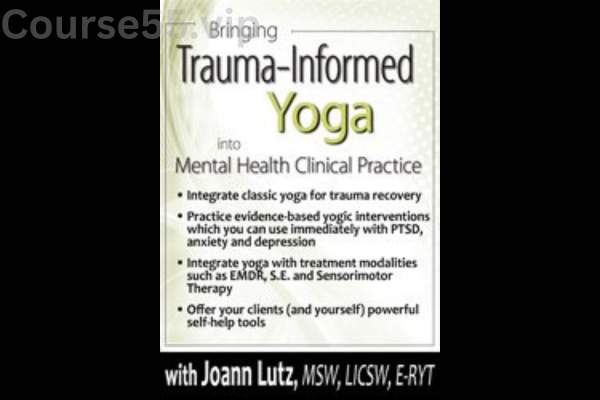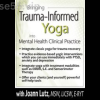-
×
 Healthy Hormone Done-For-You By Lorene Sauro
1 × $23.10
Healthy Hormone Done-For-You By Lorene Sauro
1 × $23.10 -
×
 Intermediate To Advanced Breath-Control Course By Simon Borg-Olivier
1 × $39.00
Intermediate To Advanced Breath-Control Course By Simon Borg-Olivier
1 × $39.00 -
×
 Self-Regulation & Executive Functioning in Children and Adolescents: Visual Strategies and Hands-on Techniques to Provide Structure, Predictability, and Routines By Kathy Morris
1 × $23.10
Self-Regulation & Executive Functioning in Children and Adolescents: Visual Strategies and Hands-on Techniques to Provide Structure, Predictability, and Routines By Kathy Morris
1 × $23.10
Bringing Trauma-Informed Yoga into Mental Health Clinical Practice By Joann Lutz – PESI
$199.00 Original price was: $199.00.$23.10Current price is: $23.10.
SKU: C55vip.11011wmmBYvY2
Category: Download
Tags: Bringing Trauma-Informed Yoga, into Mental Health Clinical Practice, Joann Lutz - PESI, Trauma-Informed
Bringing Trauma-Informed Yoga into Mental Health Clinical Practice: A Comprehensive Review by Joann Lutz – Digital Download!

Bringing Trauma-Informed Yoga into Mental Health Clinical Practice By Joann Lutz – PESI
Overview

Integrating Trauma-Informed Yoga into Mental Health Practice: A Comprehensive Overview by Joann Lutz
In recent years, the incorporation of trauma-informed yoga into mental health therapy has garnered significant attention from practitioners. Joann Lutz’s comprehensive review, Bringing Trauma-Informed Yoga into Mental Health Clinical Practice, highlights the intricate connections between trauma and the body’s physiological responses, particularly focusing on the autonomic nervous system (ANS). This synergy between yoga-based physical practices and psychotherapy offers a holistic approach to mitigating trauma-related symptoms. Lutz explores how advancements in trauma research enhance therapeutic interventions through the integration of yoga.
Her analysis delves into the symptoms associated with post-traumatic stress disorder (PTSD) and the effectiveness of trauma-sensitive yoga techniques in alleviating distress. The review places emphasis on the role of trauma-informed chair yoga postures, demonstrating their benefits in both individual and group therapy settings. Group participation fosters a sense of connection and shared healing, reinforcing the therapeutic process. Furthermore, Lutz underscores the significance of deep relaxation methods as an integral aspect of mental health treatment.
Exploring the Link Between Trauma and the Autonomic Nervous System
A central theme in Lutz’s review is the relationship between trauma and the ANS. Extensive research illustrates how trauma leads to ANS dysregulation, perpetuating chronic stress responses. The review draws upon neuroimaging studies and animal behavior research to illustrate how trauma-induced physiological changes contribute to mental health challenges.
Effects of Trauma on the ANS
Experiencing trauma often triggers the body’s protective mechanisms, causing an individual to enter a prolonged state of heightened alertness, commonly referred to as ‘fight or flight.’ When sustained, this response can result in heightened anxiety, panic attacks, and other psychological difficulties. Notable symptoms of ANS dysregulation include:
• Increased Heart Rate: Persistent states of hyperarousal contribute to elevated heart rates and anxiety.
• Hypervigilance: Excessive alertness to potential threats disrupts daily functioning and social interactions.
• Inability to Relax: Many trauma survivors struggle with calming their bodies and minds.
Lutz asserts that integrating trauma-informed yoga into therapy can aid in ANS regulation. Specific postures and breathing exercises equip individuals with strategies to manage physiological responses, paving the way for emotional stabilization and recovery.
Chair Yoga as a Therapeutic Tool
A distinctive aspect of Lutz’s review is her focus on chair yoga as an accessible alternative for individuals with physical limitations or those in non-traditional therapy environments such as hospitals and community centers. This modified form of yoga allows clients to engage in postures without requiring floor-based movements, making it an inclusive therapeutic approach.
Advantages of Chair Yoga in Therapy
Incorporating chair yoga into clinical practice provides numerous benefits:
• Accessibility: Individuals with varying levels of mobility can engage in yoga without physical strain.
• Familiarity and Comfort: The use of chairs creates a supportive and less intimidating environment for participants.
• Gentle Movement: Encouraging mild physical activity helps clients reconnect with their bodies safely.
By utilizing chair yoga, mental health practitioners can foster a therapeutic setting that nurtures both emotional and physical resilience, reinforcing the recovery process.
Yogic Deep Relaxation Techniques for Healing
Beyond movement-based practices, Lutz underscores the role of yogic deep relaxation techniques in trauma recovery. These practices enable individuals to access states of profound calm, essential for healing.
Key Relaxation Techniques
Lutz presents several yogic techniques that can be incorporated into therapy sessions:
• Yoga Nidra: A guided meditation practice often termed “yogic sleep,” which facilitates deep relaxation while maintaining awareness.
• Breathwork: Controlled, rhythmic breathing techniques stimulate the parasympathetic nervous system, promoting relaxation and countering stress responses.
• Visualization: Guiding clients to imagine tranquil environments enhances feelings of safety and emotional stability.
These approaches are supported by empirical research, which demonstrates that yoga-based interventions significantly reduce symptoms of trauma-related disorders such as PTSD, anxiety, and depression.
Prioritizing Safety and Empowerment in Trauma Recovery
Lutz consistently emphasizes the necessity of creating a safe and empowering environment for trauma survivors. Trauma-informed yoga not only alleviates distress but also fosters resilience and self-agency.
Establishing a Secure Therapeutic Space
The therapeutic environment plays a crucial role in facilitating healing. Essential considerations include:
• Non-Judgmental Atmosphere: Providing a space free of criticism encourages open expression.
• Client-Centered Approach: Empowering clients to participate actively in their healing enhances therapeutic outcomes.
• Informed Consent: Ensuring that clients understand and consent to practices maintains their autonomy.
By implementing these principles, mental health professionals can optimize therapy sessions to meet the unique needs of trauma survivors.
Expanding Trauma-Informed Yoga to Diverse Settings
Lutz explores the broader applications of trauma-informed yoga beyond traditional clinical settings. She highlights its effectiveness in diverse populations, including military personnel and incarcerated individuals, illustrating its adaptability across various contexts.
Specialized Applications
• Veterans and Military Personnel: Many veterans suffer from combat-related trauma. Integrating yoga into military rehabilitation programs has proven to reduce PTSD symptoms and enhance mental well-being.
• Correctional Facilities: Yoga interventions in prison settings have been linked to improved emotional regulation and reduced aggression.
These case studies underscore the far-reaching benefits of trauma-informed yoga in fostering healing across different environments.
Scientific Validation and Future Directions
Throughout her review, Lutz emphasizes the growing body of research supporting the effectiveness of trauma-informed yoga in mental health treatment. She examines multiple studies that demonstrate the capacity of yoga to mitigate trauma-induced stress responses and promote psychological well-being.
Empirical Support for Yoga in Trauma Therapy
Key findings from research studies include:
• Regulation of Stress Hormones: Yoga practice has been shown to lower cortisol levels, reducing the physiological impact of trauma.
• Community Healing: Engaging in group-based yoga fosters a sense of connection and support, reinforcing the therapeutic process.
Lutz calls for continued research to examine the long-term benefits of trauma-informed yoga, advocating for its integration into mainstream mental health practices.
Conclusion
Joann Lutz’s review, Bringing Trauma-Informed Yoga into Mental Health Clinical Practice, serves as a valuable resource for clinicians seeking to expand their therapeutic approaches. By incorporating yoga-based techniques into clinical settings, practitioners can offer clients a holistic healing modality that addresses both physiological and psychological aspects of trauma. As research continues to highlight the connections between trauma and the autonomic nervous system, Lutz’s insights provide a compelling case for the integration of trauma-informed yoga into mental health treatment.
In an era where mental health challenges are increasingly prevalent, Lutz’s work offers a promising perspective on harnessing the power of yoga to foster healing, resilience, and emotional well-being.
Frequently Asked Questions:
Business Model Innovation: We operate a group buying strategy, allowing participants to share costs and access popular courses at reduced prices. This model benefits individuals with limited financial resources, despite concerns from content creators about distribution methods.
Legal Considerations: The legality of our operations involves complex issues. Although we don’t have explicit permission from course creators to resell their content, there are no specific resale restrictions stated at the time of purchase. This ambiguity creates an opportunity for us to provide affordable educational resources.
Quality Control: We ensure that all course materials purchased are identical to those offered directly by the creators. However, it’s important to understand that we are not official providers. As such, our offerings do not include:
– Live coaching calls or sessions with the course author.
– Access to exclusive author-controlled groups or portals.
– Membership in private forums.
– Direct email support from the author or their team.
We aim to reduce the cost barrier in education by offering these courses independently, without the premium services available through official channels. We appreciate your understanding of our unique approach.
Be the first to review “Bringing Trauma-Informed Yoga into Mental Health Clinical Practice By Joann Lutz – PESI” Cancel reply
You must be logged in to post a review.
















Reviews
There are no reviews yet.